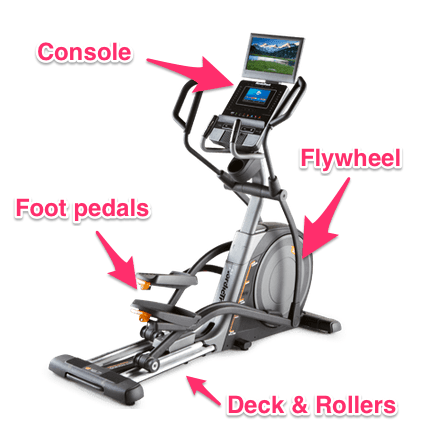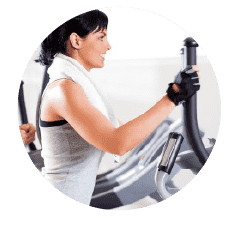4 Elliptical Parts You Should Know
Elliptical trainers are built to be easy on the joints, without the harsh impact on joints. Here are a four main components of an elliptical you should know about.
Flywheel
The flywheel is the drive system to an elliptical trainer; it’s what moves when you apply pressure to the pedals, and it’s also the part that controls the resistance levels.
The flywheel weight is directly connected to how smooth an elliptical trainer will maneuver, and how loud the system will operate overall. So, it’s a pretty good part to know about. The flywheel is what allows the pedals and hand grips to move, and a heavier flywheel also determines the life span of your elliptical. Flywheel weights can vary as widely as 13 to 35 pounds, depending on the brand.
If the flywheel is in the front of the machine, it is called a front drive trainer, and if it is in the back of the machine, it is called a rear drive trainer. Recently, new models are coming out where the flywheel is at the center of the machine, called a center drive trainer. While each of these types has their own pros and cons, most in-home, more compact and less expensive elliptical trainers are front drive design. Rear drive trainers are typically bulkier, more expensive, and not as common for in-home use. However, it essentially comes down to personal preference on which is the “best” fit for users. Front drive trainers maneuver more like a stair climber while rear drive trainers operate more like a cross between running and walking.
Electronic System
The electronic system consists of the console and basically any feature that works while the machine is plugged in, such as power adjustable features like adjustable incline. This is an essential part to know for a number of reasons. First, your warranty comes into play with the electronic system, so read the fine print on all warranties. Some brands will say they offer a 3 year parts and labor warranty, but if you read closely this may or may not exclude the electronic system of the trainer. The quality of the console is also important if you are looking for preset workout programs and goal tracking features that include heart rate monitoring. Most trainers will offer a minimum of eight preset programs, but typically only more standard home use and elite trainers will offer wireless heart rate monitoring capabilities.
Deck and Rollers
Hearing squeaks coming from your elliptical trainer and can’t find out where? Check between the rails and the wheel; the most common place for squeaks to originate. While this is a relatively simple fix with some rail lubricant, understanding how the rollers work and the importance of sturdy rollers will help. The actual deck that contains the rollers is equally important to the comfort and feel of an elliptical trainer. When considering a trainer, pay attention to the stride length, which is the length of the rollers from the front to the back of the deck, or the distance the pedals move during the elliptical motion. A longer stride means more room to move your legs front to back while a shorter stride means less space to move your legs from front to back, but this isn’t necessarily a bad thing depending on your height and preferences. While a longer stride might be ideal for a taller person or a person with longer legs, it can actually be less than ideal for a shorter person and can even cause discomfort in the lower back. Similar problems arise for a taller person on a shorter stride; they may feel too restricted in the pedals. The ideal scenario is to find a trainer that offers an adjustable stride so multiple users can comfortably use the same machine. Most trainers will offer stride lengths anywhere from 18 to 24 inches.
Foot Pedals
On an elliptical trainer, the foot pedals are an essential part of the workout experience. If the foot pedals are uncomfortable, it can lead to everything from lower back issues to shin splints. For a detailed explanation, see our review on ellipticals with the most comfortable foot pedals. Here are a few things to look for with the foot pedals on an elliptical trainer: the cushioning, the design, and the size. Cushioning is usually a top feature of a quality foot pedal, and many brands offer cushioning that also features tread to keep your feet firmly placed on the pedals. Some models will design their foot pedals to incline slightly inward, and even pivot. The inward slop is intended to relieve pressure on the knees, while the pivoting motion is designed to allow more movement of the ankles. The size of the pedals is important to consider as well. Most brands will advertise “oversized foot pedals,” but what does this mean, and is that a good thing even if you have smaller feet? Oversized foot pedals are typically beneficial for most users because it gives the feet space and avoids cramping. Of course, cushioning and tread go hand in hand with size because if the pedals are too big and lack tread, it can make for an uncomfortable scenario. Many of the elite models will also offer adjustable foot pedals.




 Compact/Folding
Compact/Folding Front Drive
Front Drive Rear Drive
Rear Drive